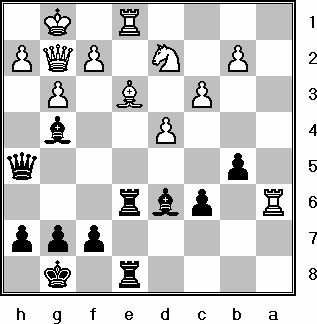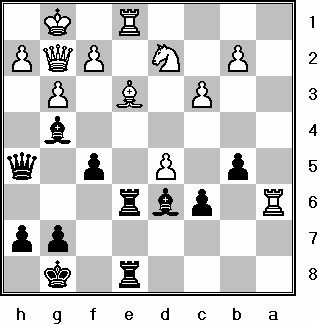|
Lesson
#16
The Razor's Edge
In the jungle of the sixty four squares sometimes all is calm. The position
is simple and comfortable. Events unfold slowly and naturally. But, on other
occasions, the wind blows ferociously. It’s hard to get your bearing. The
chess pieces seem to be flying around the board in unexpected ways. At those
times, each move is a challenge. And only the very best will do.
Sometimes a chess game is so sharp it’s like a razor’s edge. The path to
success is very thin. And danger is everywhere. This makes for exciting chess
for the spectators but severely tests the nerves of the combatants. Whose attack
will be stronger? How can I defend and attack at the same time? How much time do
I have left? Why are all these people watching?
Today I’d like to share an ultra-sharp game that decided the 1997 National
High School Championship. It was played in the final round with ESPN television
and several chess masters watching. Harutjun Akopyan (playing white) was trying
for his 10th US Scholastic Title. William Lopes (playing black) was the underdog
who had already beaten a number of higher rated juniors to reach the top board.
|

|
Black to move
|
The position to the right resulted from a Marshall Attack in the Ruy Lopez.
Black has strong attacking chances for the pawn. His two bishops have lots of
scope while the white minor pieces are only holding down the fort. Black would
love to break open the e-file. But his queenside pawns are about to fall. What
should he do?
After a deep think, black uncorks a fine move with 1. … f5! This
threatens 2. … f4 and gives an all-important escape hatch for his own king.
The tension is high. Both players are spending about 10 minutes per move –
giving the crowd much to whisper about. 2. Rxc6 exposes the white king to too
many threats as in 2. … f4 3. gxf4 Rg6 4. Rxd6 Rxd6 5. Ne4 (with the idea of
plugging up the kingside with Ng3) Rxe4! 6. Qxe4 Bf3 winning.
The defending champion found a sharp resource with 2. d5! This takes
advantage of the fact that black’s f5 move temporarily blocked his queen’s
defense of that square.
|

|
Black to move
|
Black has been focusing on breaking through at f4. Meanwhile, white breaks in
the center. There are four possible moves for black to consider: Rf6, Rxe3, the
zwischenzug Bh3 (zwischenzug is German for in-between move) and Rg6.
A) In the actual game black played 2. … Rf6 to support his pawn
push on the f-file. White chopped with 3. Rxc6 and after 3. … f4 4.
Ne4! white is threatening to take the rook with check! There followed 4.
… Rxe4 5. Qxe4 Bf5 (5. … Bf3 was perhaps a better try) 6. Qd4
White eventually won because his active rook and three pawns were too much
against two bishops. With this win Akopyan won his unprecedented tenth National
title.
But let us go back. Did black have a better move than 2. … Rf6?
B) 2. … Rxe3 3. fxe3 Bc5 looks promising for at first. But after 4. Nf1
there does not seem to be much of an attack left. If only the white queen wasn’t
on g2. That brings up the third try.
C) 2. … Bh3 puts the question to the white queen. If white tries 3.
Qf3 black could repeat moves with 3. … Bg4 4. Qg2 Bh3 and accept a draw and a
share of the National title. If, on the other hand, white plays to win, he must
bury his queen with 3. Qh1. Now we can use the idea that we discarded earlier
and play 3. … Rxe3 4. fxe3 Rxe3 with some sting! White looks lost here. After
5. Rxe3 Qd1+ wins. Or, after 5. Raa1 Bc5 wins nicely. Unfortunately, black can
simply play 5.Kf2 and hold his extra material.
D) The fourth try is 2. … Rg6. This threatens the f4 pawn push but
avoids the embarrassment of white’s Ne4. However, white can stop this by
playing 3. f4 himself! After 3. … Bxf4 4. Qf2 it will be white’s turn to
attack.
What to do? Nothing seemed to work. But there is a way. Sharpen your pencil
and try combining the last two ideas. The best move is 2. … Bh3! and
after 3. Qh1 Rg6! Now the white queen can’t get to f2. The
position continues to be unclear. I’ll leave you with one example: 4. Rea1 f4
5. Ra8 Bc8! 6. Bb6 cxd5 and black stands well. It is now white that must work
hardest to defend at the razor’s edge.
Home Page ·
More Lessons
(c) 2001 Ross Stoutenborough
|